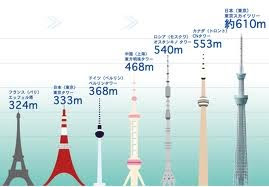::::::::::::::::::::::::::::::::::::::::::::::::::::::::::::::::::::::::::::::::::::::::::::::::::::
The Japanese Food Saijiki
和食歳時記
:::::::::::::::::::::::::::::::::::::::::::::::::::::::::::::::::::::::::::::::::::::::::::::::::::::
New Year Food, Neujahrsessen
***** Location: Japan
***** Season: New Year
***** Category: Humanity
*****************************
Explanation
There are many food specialities for the New YEAR in Japan.
In Alphabetical order of the Japanese.
Use your browser to find a word, please !
:::::::::::::::::::::::::::::::::::::::::::::::::::::::::::::::::::::::::::::::::::::::::::::::::::::
Food of the New Year Season, O-Setchi Ryori
(osetchi ryoori おせち料理, 御節料理 )
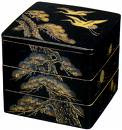 The Japanese New Year lasts for three days, when the housewife is not supposed to do any cooking, except for the New Year Soup. So all is prepared in beautiful boxes (jubako 重箱) and served to the family and to the many seasonal visitors. Sharing the food with visitors was the custom called kuitsumi 食摘み, くいつみ during the Edo period.
The Japanese New Year lasts for three days, when the housewife is not supposed to do any cooking, except for the New Year Soup. So all is prepared in beautiful boxes (jubako 重箱) and served to the family and to the many seasonal visitors. Sharing the food with visitors was the custom called kuitsumi 食摘み, くいつみ during the Edo period.There are usually three layers of the boxes, the first contains the entree and hors d'oeuvre, the second has the fish and the lowest one the boiled vegetables. Sometimes there is a fourth box with more side dishes.
Most dishes are choosen because they are "engi ga yoi", auspicious of some kind, with a pun.
Japanese are very fond of engimono of all kinds.
. Engimono 縁起物 little things for good luck .
::::::::::::::::::::::::::::::::::::::::::::::::::::::::::::::::::::::
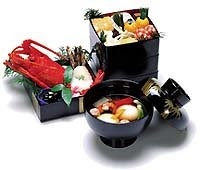
Collectively known as osechi ryori, these dishes are served generally on the first three days of January, usually at breakfast, when the whole family is together. Tradition has it that they will bring good health to all throughout the year. This cuisine is beautifully arranged in tiered lacquered boxes called jubako.
The name of each osechi food has a fortuitous meaning, either through a play of words or the resemblance of the food with an auspicious item.
For example:
Kazunoko (herring roe) symbolizes prosperity for one's descendents because this delicacy consists of many eggs.
Kuromame (black boiled beans) symbolizes being hardworking or industrious.
Gomame (small dried sardines) symbolizes a bumper crop or rich harvest.
Kobumaki (rolled seaweed) symbolizes pleasure or delight.
Ebi (prawn) symbolizes a wish for long life.
Another New Year's favorite is ozoni, a soup containing sticky rice dumplings (Omochi). Every area has its own recipe. People from the Kanto district, for example, like the soup seasoned with soy and square rice dumplings, while people from the Kansai district prefer soup made with miso (fermented bean soy paste) and round rice dumplings.
http://www.ajinomoto.com/traditions/winter_02.html
Sechi burumai 節振舞 (せちぶるまい)
treating visitors to New Year Food
sechi ae 節餐(せちあえ), toshi no ae 年の餐(としのあえ)
day for eating sechi food, sechi no hi 節の日(せちのひ)
"rice in a bowl", ooban 椀飯(おうばん)
entertaining visitors, ooban burumai 椀飯振舞(おうばんぶるまい)
New Year's Food, sechi ryoori 節料理(せちりょうり)
visitor for the New Year's Food,
sechi kyaku 節客(せちきゃく)
special guest room for this occasion,
sechi zashiki 節座敷(せちざしき)
::::::::::::::::::::::::::::::::::::::::::::::::::::::::::::::::::::::::::::::::::::::::::::::::::::::
:::::::::::::::::::::::::::::::::::::::::::::::::::::::::::::::::::::::::::::::::::::::::::::::::::
Acharazuke 阿茶羅漬 (あちゃらづけ, 阿茶羅漬け)
sliced turnips in vinegar dressing
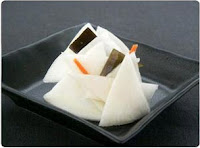 A typical dish of Kyoto and the Kansai area. Radishes and turnips are used most often and some cut kombu seaweed and carrots are added. A special vinegar brew with soy sauce, sugar and sweet ricewine is added (sanbaizu 三杯酢).
A typical dish of Kyoto and the Kansai area. Radishes and turnips are used most often and some cut kombu seaweed and carrots are added. A special vinegar brew with soy sauce, sugar and sweet ricewine is added (sanbaizu 三杯酢).It is often eaten at the end of a course.
:::::::::::::::::::::::::::::::::::::::::::::::::::::::::::::::::::::::::::::::::::::::::::::::::::::
Bai no mi 海蠃の身 (ばいのみ) flesh of the bai conch
Babylonia japonica (貝、蛽、海蠃、海螄, バイ)
CLICK for photo !
The shell has the form of half a circle, with some black spots. It ressembles the tanishi shells of the rice paddies, but is a bit longer. It lives in the sandy beaches of many bays.
The white flesh is boiled in sweetened soy sauce. The shells are used by children as spinning tops.
Since poor farmers in the Edo period could not afford expensive food, they also used the normal tanishi conches as food. These were called
nishizakana 螺肴 (にしざかな) , conch snacks.
::::::::::::::::::::::::::::::::::::::::::::::::::::::::::::::::::::::::::::::::::::::::::::::::::::
chokudaigashi 勅題菓子 (ちょくだいがし)
sweets served for the New Year Imperial Poetry Contest
shokudaika 勅題菓(ちょくだいか)gyodaigashi御題菓子(ぎょだいがし)
. . . CLICK here for Photos !
Chorogi 草石蚕 (ちょろぎ) knotroot , Knollenziest
甘露子, 滴露, 丁呂喜,、長老木
 Stachys sieboldii(Stachys affinis).
Stachys sieboldii(Stachys affinis).The roots are colored with red shiso perilla juice to make an auspicious color. They are often served together with black beans. This plant has been introduced from China during the Edo period. It is alse a medicinal plant and now available during the whole year.
:::::::::::::::::::::::::::::::::::::::::::::::::::::::::::::::::::::::::::::::::::::::::::::::::::::
Daikon iwau 大根祝う (だいこんいわう)
"celebrating with radish"
decorating radish, daikon kazaru
大根飾る(だいこんかざる)
It is often placed above the kagami mochi.
This decoration was used for the ceremony of . . . "strengthening the teeth", hagatame . 歯固.
The radish can also be put into zoni soup later.
Radish is a typical vegetable of winter, good for digestion and has been the subject of Japanese poetry since olden times.
Radish (daikon) Pickled radish, takuan.
:::::::::::::::::::::::::::::::::::::::::::::::::::::::::::::::::::::::::::::::::::::::::::::::::::::
Fukucha ... 福茶 "Good Luck Tea"
..... oobuku, oofuku 大服
..... oofukucha, oobukucha 大福茶 , 皇服茶
..... ofukucha 御福茶
:::::::::::::::::::::::::::::::::::::::::::::::::::::::::::::::::::::::::::::::::::::::::::::::::::::
Ganjitsu no Sechi-E 元日節会
Audience and Reception of Politicians
Introduced after the Meiji Reformation. The Emperor meets with the politicians for a first audience and exchanges a glass of ricewine.
Hare no Gozen 晴の御膳 Official Lunch Reception
Hare no Omono 晴御膳 はれのおもの
..... Gozen no gi 御膳の儀
In the Phoenix Hall of the Imperial Palace. Now it can be held on any of the first three days of the new year.
The menu was composed first in the Heian period and is still served today.
vinegar, ricewine, salt and soy sauce, the four condiments
plum branches, baishi 梅枝(ばいし)
Rice flouer was kneaded into the shape of plum branches. They were fried in oil before serving.
peach branches, tooshi 桃枝(とうし)
The same as the plum branches, but in a different form.
"scorpion snack", kakko かっこ 餲餬, □餬
Snacks kneaded with wheat flour, in the shape of a scorpion (蝎 すくもむし sukumomushi). They were either fried or steamed. Also called kappei かっぺい. pei ぺいwas another word for mochi 餅.
dumplings with cinnamon, keishin けいしん 桂心
Wheat or glutinous rice flour and medical cinnamon where kneaded into a form of a three-cornered priest hat. Fried in oil.
round dumplings, tsuishi ついし 鎚子
made from flower, rolled round like "bullets", or round "like satoimo potatoes", then fried or boiled.
"navel cakes" densei, tensei てんせい 黏臍/ (でんせい)
dumplings with a shape of the human navel. Made from flower, then fried.
crackers, hitsura, hichira, hira ひつら,ひちら 饆饠
Made from rice flour mixed with foxtail millet (awa) and millet (kibi). Round and flat types of bisquits, almost like our rice senbei these days.
Others are made of wheat flour and inside is anko sweet bean paste. hira ひら
Also a kind of mochigome 糯米 is used.
dumplings, danki だんき 団喜, kankidan 歓喜団
Made from wheat flour and flour of green beans (edamame), with some poppy seeds (keshi) and dried lotus. Fried in sesame oil. Today they are still used as offerings in Buddhist rituals.
Also called danki 団喜(だんき).
Modern seijoo kankidan 清浄歓喜団 have the ingredients wrapped in the dough like a pouch.
. . . CLICK here for Photos !
Others (altogether there are 14 differenr types
14種の果餅(かへい)kahei
dumplings, konton こんとん 昆飩 餛飩
round dumplings with minced meat and vegetables, served with broth
noodles, sakubei さくべい 索餅
The oldest form of the noodles, sakubei, produced by adding rice powder to flour, was introduced from China in the eighth century. Now we have udon and soomen nodles.
crackers, senbei 煎餅
Wheat flour and rice flour are mixed, rolled round and fried in oil. The beginning of our senbei.
dumplings, hakutaku 餺飥(はくたく)
Wheat flour is kneaded and rolled flat until they are all of the same size. Tooshi Chooja of the Fujiwara clan ate them always at the shrine Kasuga Taisha.
Now they are called Hootoo ほうとう, a kind of udon, a speciality of Yamanashi pref.
Yamanashi : Hootoo noodles
The above types of snacks were also introduced from China in the Heian period. There are eight famous snack from China (hasshuu no karagashi, yakusa no kara kudamono 八種の唐菓子, 八種唐菓子). This custom of serving them shows the strong influence of the Chinese culture on the aristocracy during the Heian period. The lists do differ in including various snacks.
They are mostly made of rice or wheat flour, kneaded into auspicious shapes, filled with minced meat or vegetables and fried for consumption. They were also called "fruit" kudamono 果物.
KU meand KI, tree, "ki no mono" like nuts. These snacks were made from the fruits of trees also.
Another old meaning of KUDAMONO is "fish snacks to be eaten with ricewine".
Snack from the Heian Period
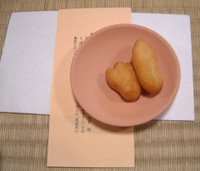
http://evagenji.hp.infoseek.co.jp/kudamono1.htm
http://www.meikatanbou.com/chi_/chi_w/w_s055.htm
http://www2u.biglobe.ne.jp/~heian/kenkyu/gourme/okasi.htm
and
Hagatame, O-Hagatame (teeth strenghtening)
tooth hardening, teeth hardening
hagatame 歯固 歯がため はがため
rice cakes for strengthening the teeth
..... hagatame no mochi 歯固の餅 はがためのもち
Diamond Petal Rice Cakes
..... hishi hanabira mochi, 菱葩餅 ひしはなびらもち
ooooooooooooooooooooooooooooooooooooooooooooo
quote
Tang confectionery
Japan sent envoys to the Sui and Tang Dynasty from the Asuka period to the beginning of the Heian period. They brought back eight Tang confectioneries (唐菓子 ,Tō-gashi or kara-kudamono) and 14 grain flour-based confectioneries (果餅) and the recipes. The Tang confectioneries were kneaded wheat flour and rice flour, and fried in oil. These were more advanced than the confectionery technology of Japan in those days. They were served at the Imperial Court and offered to Shintoist and Buddhist deities.
According to one view, a dark brown sugar was also brought back from China by Jianzhen who came to Japan from the Tang in this period. However, since sugar-refining technology was not introduced to Japan at this point, the sugar was very rare and was treasured like a medicine. Generally, the syrup that resulted from boiling the sap of Grape ivy down (甘葛煎 ,amazura-sen) was used as a sweetener at this time.
During this period, many diaries and tales were written among upper class and aristocrats. The Tale of Genji, The Pillow Book and The Diary of Izumi Shikibu have some episodes about confectionery. Moreover, the records manifesting a life situation also increased with improvement of a government institution. They are how we know confectionery culture of those days.
Tang confectioneries
Major eights: Baishi, Danki, Hichira, Kakko, Keishin, Tensei, Tōshi and Tsuishi.
Others: Buto, Fuzuku, Heidan, Hōtō (According to one theory, it is an archetype of Hōtō hootoo), Kakunawa, Konton, Magari, Mugikata and Sakuhei (sakubei).
Aozashi: It is made of parched green wheat flour and twisted like a thread.
Kezurihi: Shaved ice flavored with amazura-sen syrup. It is called kakigori today.
..... Some mochi-based confectioneries. For example:
Tsubaki mochii: A mochi flavored with amazura-sen syrup.
Inoko mochii: A mochi shaped as a wild boar piglet.
© More in the WIKIPEDIA !
. WASHOKU
Neujahrsessen bei Hofe
:::::::::::::::::::::::::::::::::::::::::::::::::::::::::::::::::::::::::::::::::::::::::::::::::::::
Gomame ごまめ , 五万米(ごまめ)
"preparing the fields", tatsukuri 田作(たづくり) )
kotono bara 小殿原(ことのばら)
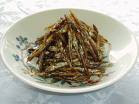 Small dried sardines, broiled in sweetened soy sauce. They are also served on other felicitous occasions. During the Edo period, farmers prepared fertilizer for the fields from small sardines and ash from the hearth.
Small dried sardines, broiled in sweetened soy sauce. They are also served on other felicitous occasions. During the Edo period, farmers prepared fertilizer for the fields from small sardines and ash from the hearth.These fish are eaten with the wish for a bountiful harvest.
:::::::::::::::::::::::::::::::::::::::::::::::::::::::::::::::::::::::::::::::::::::::::::::::::::::
hatsutawara 初俵(はつたわら)"first bundle of rice"
first namako Holothurie (Seewalze, Seegurke)
tawarago 俵子 たわらご , 俵魚(たわらご)
kinko 金海鼠(きんこ), iriko 煎海鼠(いりこ)
Haze 葩煎 (はぜ) "popped" rice
"rice flower", komebana 米花(こめばな)
vendor of haze, haze uri 葩煎売(はぜうり)
bag to sell haze, hasebukuro 葩煎袋(はぜぶくろ)
Prepared from roasted glutinous rice (mochigome). The result looks like a white "flower" of the rice. It was often served to visitors.
It was often placed on a special decoration shelf (hoorai dai 蓬莱台) which symbolized the Buddhist mountain Horai in China, where people would live forever.
This custom has died out, but even nowadays some of this popped rice is sold at the festival of some temples and shrines in Osaka.
komebanatoo 米花糖 sugar like "rice flowers"
in the colors green, yellow, red, pink and white, which looks gaudy.
:::::::::::::::::::::::::::::::::::::::::::::::::::::::::::::::::::::::::::::::::::::::::::::::::::::
Hirakimame 開豆 (ひらきまめ) "open" boiled soybeans
Some beans open a bit when boiled. They are picked out especially and added on an extra dish. This is a word play with "opening the good luck", kai-un 開運.
Hiraki goboo 開牛蒡 (ひらきごぼう) "open" burdock
"divining sticks" burdock, sangi goboo 算木牛蒡(さんぎごぼう),
"crushed" burdock tataki goboo 叩牛蒡(たたきごぼう)
The long burdock roots are inscised various times and boiled long as they are. They resemble the divining sticks of temples and shrines. Sometimes the burdock is crushed. Sesame is added for flavor.
Wish to become as strong as the burdock root in the coming year.
In Kansai, it is used instead of kuromame black beans for the three side dishes (mitsuzakana).
:::::::::::::::::::::::::::::::::::::::::::::::::::::::::::::::::::::::::::::::::::::::::::::::::::::
Imogashira 芋頭 (いもがしら) tubercle of taro potatoe
imo no kami 芋の頭(いものかみ), kashira imo 頭芋(かしらいも)
celebrating with taro, imo no kami iwau
芋の頭祝う(いものかみいわう)
imogashira iwau 芋頭祝う(いもがしらいわう)
This is a pun with the word "kashira", being the head of a group, and is therefore considered auspicious food.
It is either put into the zoni soup or prepared boiled as a side dish.
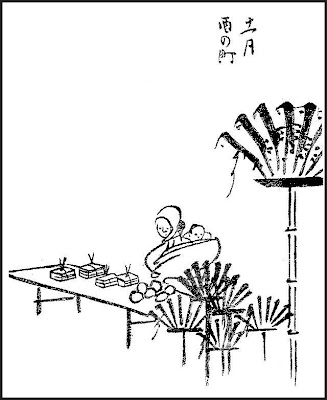
Scened of Edo
Vendor of things for the new year, including the taro potatoes
:::::::::::::::::::::::::::::::::::::::::::::::::::::::::::::::::::::::::::::::::::::::::::::::::::::
Kagami mochi ... 鏡餅 ... Decoration Rice cakes for the New Year
Their decorations are full of auspiciuos symbols.
:::::::::::::::::::::::::::::::::::::::::::::::::::::::::::::::::::::::::::::::::::::::::::::::::::::
Kazu no ko 数の子 (かずのこ) , 鰊鯑(かずのこ)
kado no ko かどのこ
shio kazunoko 塩数の子(しおかずのこ)
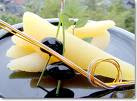
Herring roe. Herring is also called "kado" in the language of the Ainu. The name derived from kado-no-ko "children of kado fish". it comes dried or salted and is a MUST for the New Year. Because there are millions of eggs in a herring ovary, it symbolizes good luck with many children and generations of the family.
:::::::::::::::::::::::::::::::::::::::::::::::::::::::::::::::::::::::::::::::::::::::::::::::::::::
Kirizanshoo 切山椒 (きりざんしょう) desert dish
lit. "cut mountain pepper"
A kind of sweet made from rice flour, sugar and mountain pepper. It can be cut and served over a bowl of rice for a quick snack. It is usually served steamed, which enhances the fragrance of the pepper. It is supposed to brick luck with money affairs.
A prepacked cake of this kind is also sold at the New Year Fair "Tori no ichi" at Asakusa, Tokyo.
:::::::::::::::::::::::::::::::::::::::::::::::::::::::::::::::::::::::::::::::::::::::::::::::::::::
Kobumaki, konbumaki, kombumaki 昆布巻き (こぶまき)

A roll of tang containing dried fish simmered in sweetened soy sauce.
A play of words with yorokobu, to have pleasure, to enjoy something.
Some saijiki do not list this as a kigo.
::::::::::::::::::::::::::::::::::::::::::::::::::::::::::::::::::::::::::::::::::::::::::::::::::::
Kohada no awazuke 小鰭の粟漬 (こはだのあわづけ)
Spotted shad pickled in foxtail millet
Typical New Year Food of the Kanto area. Fish of medium and small size are placed in a foxtail millet pickles mixture. This preparation can stand for many days and is therefore suitable for the cold food of this season. To get rid of all the small bones the fish is cut into three slices and salt added to the pickles mixture. When take out of the mixture, it is simmered in sweetened vinegar.
:::::::::::::::::::::::::::::::::::::::::::::::::::::::::::::::::::::::::::::::::::::::::::::::::::::
Kuitsumi 喰積 (くいつみ)
juuzume 重詰(じゅうづめ), juuzume ryoori 重詰料理(じゅうづめりょうり)
kumijuu 組重(くみじゅう), kuitsugi 食継ぎ(くいつぎ)
o-tegake お手掛(おてかけ)
o-torizome お取初め(おとりぞめ)
 Rice and food to be shared with visitors. Includes chestnuts, dried persimmons, soure oranges, konbu seaweed, popped rice and dried abalone. All this food represented auspicious symbols for the new year.
Rice and food to be shared with visitors. Includes chestnuts, dried persimmons, soure oranges, konbu seaweed, popped rice and dried abalone. All this food represented auspicious symbols for the new year.. . . Haiku with KUITSUMI
喰つみも子隅の春と成にけり
kuitsumi mo ko sumi no haru to nari ni keri
stockpiling rice
for Little New Year's...
little nook of spring
Kobayashi Issa
Tr. David Lanoue
:::::::::::::::::::::::::::::::::::::::::::::::::::::::::::::::::::::::::::::::::::::::::::::::::::::
Kuromame 黒豆 (くろまめ)black beans

mame also means diligent hardworking and healthy, so the beans are eaten with the wish to stay healthy and not experience any disaster in the coming year.
:::::::::::::::::::::::::::::::::::::::::::::::::::::::::::::::::::::::::::::::::::::::::::::::::::::
Musubi konbu 結昆布 (むすびこんぶ)
finely cut kombu seaweed
musubi kobu 結びこぶ(むすびこぶ)
mutsumi konbu 睦み昆布(むつみこんぶ)
It is placed in the "Lucky Tea" and the zoni soup.
A play of words with yorokobu, to have pleasure.
:::::::::::::::::::::::::::::::::::::::::::::::::::::::::::::::::::::::::::::::::::::::::::::::::::::
Noshi 熨斗 (のし) abalone decoration
long noshi, naganoshi 長熨斗(ながのし)
abalone noshi, noshi awabi 熨斗鮑(のしあわび)
打熨斗(うちのし)、
thin abalone, usu awabi 薄鮑(うすあわび)
A thin strip of dried abalone wrapped in folded red and white paper or served on a piece of green bamboo. It used to be eaten, but since the Edo period became a piece of decoration. Because the meat of the abalone tends to strech long, it is a symbol of the long and good human relations. Now even paper imitations of a noshi can be used.
Noshibukuro, envelop for presenting money
:::::::::::::::::::::::::::::::::::::::::::::::::::::::::::::::::::::::::::::::::::::::::::::::::::::
Oobuku, oofuku ... 大服
New Year's Tea, Good Luck Tea (fukucha)
:::::::::::::::::::::::::::::::::::::::::::::::::::::::::::::::::::::::::::::::::::::::::::::::::::::
Oshi ayu 押鮎 (おしあゆ) pressed sweetfish
The fish is salted and kept in a pot with a heavy stone on the lid for pressing.
This food was used for the ceremony of . . . "strengthening the teeth", hagatame . 歯固.
Because of its fast growth during just one year it is auspicious to eat it during the New Year days. It is a speciality of the Tosa area of Shikoku, but now eaten all over Japan.
It is also called "fish of one year", nengyo 年魚.
It is now the prefectural fish of Gunma.
押鮎や日に日に十句たまりゆく
oshi ayu ya hi ni hi ni tooku tamariyuku
pressed sweetfish -
every day, every day
10 more new haiku
Ozawa Katsumi 小澤克己
source : 鮎 ..62句
Tr. Gabi Greve
:::::::::::::::::::::::::::::::::::::::::::::::::::::::::::::::::::::::::::::::::::::::::::::::::::
Ryoo no mono 料の物 (りょうのもの) two side dishes
..... 両の物(りょうのもの)
Beside the main tray with New Year food, there are two small dishes, one on each side, which contain some beans or other vegetables. This is an old custom of decoration from Kyoto.
Sometimes they are also placed on both sides of the zoni soup container.
Open soybeans, open burdock and fern are used most often for these dishes.
:::::::::::::::::::::::::::::::::::::::::::::::::::::::::::::::::::::::::::::::::::::::::::::::::::::
Sainichi 斎日, さいにち Fasting day, sixteenth day
During the season of the New Year and O-Bon, on the sixteenth day,the memorial day of Enma, King of Hell, everyone took a day off and fasted. Servants and monks and sometimes even the prostitutes were sent home for a general holiday (yabu iri, yabu-iri 薮入), so the stores closed early and most people stayed at home with the family. Holidays like this for the servants were not common during the Edo period, where they had to work seven days a week the whole year.
. The First Lunar Month 一月 ichigatsu - in Edo .
けふこそは地獄の衆もお正月
kyoo koso wa jigoku no shuu mo o-shoogatsu
today even the
hordes of hell celebrate
the new year
Issa, 1820 (Tr. David Lanoue)
Haiga by Nakamura Sakuo
Sakuo san translates "jigoku no shuu" not as the demons, but the humans that had fallen to hell after death and are usually maybe eaten by the demons. These poor sould had a day off, since the demons and all else were on a fast.
xxxxxxxxxxxxxxxxxxxxxxxxxxxxx
薮入の大輿の通りけり
yabuiri no oomikoshi no toori keri
Servants' Holiday--
the great festival shrine
passes by
Kobayashi Issa
(Tr. David Lanoue)
Read more
Emma (Enma ten, Enma Oo) 閻魔天、閻魔王)
The King of Hell and Haiku
.............................................................................
やぶ入やきのふ過たる山神楽
yabuiri ya kinoo sugitaru yama-kagura
home for a day --
the Hachiman shamans
danced yesterday
This hokku was written in Edo on 1/22 in 1804, so Issa is imagining, probably based on a memory or on something he has heard, a scene near Kyoto on 1/16. The 16th is the day when servants are allowed to return to their parents' houses to celebrate New Year's and when wives who live some distance from their natal homes return home for a day. Before Japan imported its lunar calendar from China, the day of the first full moon of the year, 1/15, may have been more important than 1/1, when the lunar year begins on the Chinese lunar calendar. By Issa's time, however, marriage had become patriarchal under warrior-class rule, and 1/1 was called Big New Year's and 1/15 was called Small New Year's. The latter was also called Women's New Year's, onago no shougatsu, and in rural areas women generally became a year older on 1/15, while men became a year older on 1/1. Both 1/15 and 7/15 were times when ceremonies were held to welcome back the spirits of the dead, and the return of wives and servants was originally for the purpose of greeting the spirits of their ancestors together with their families. On the other day of returning home, 7/16, people who went home were able to join in the ceremonies to greet their ancestors, since the large O-Bon Festival of Returning Souls was held from 7/14 to 7/16, but probably because there were two New Year's Days in the first month, Big and Small, those who returned to their hometowns on 1/16 were too late to join in the ceremonies for ancestors on 1/15. This is the situation Issa's hokku assumes.
Women from the villages around Kyoto were in great demand in the city, where they were hired as servants and maids and given lessons in "high" culture by aristocratic and merchant families, and the majority of returnees from Kyoto to the countryside around it were women, so I'll refer to the servant or wife who returns in Issa's hokku as "she." The woman's parents live a few miles south of Kyoto near Mount Otoko, literally Male Mountain. On that mountain was a very large and famous Shinto shrine and Buddhist temple complex (in Issa's time Shinto shrines and Buddhist temples were usually located next to each other and shared the power of the place), with the shrine being dedicated to Hachiman, the god-bodhisattva of shamanic flags, bows and arrows, and rice paddy fertility.
The shrine is called the Iwashimizu Hachiman Shrine, and the woman's family probably made a pilgrimage up the mountain the day before and watched sacred kagura dancing by the shrine's female shamans, whose dance was believed to welcome back the returning souls of ancestors on 1/15. The woman's parents may also have prayed at a large bonfire on the night of 1/15 in which all the implements and decorations used at Big and Small New Year's were burned and thereby sent back to the other world. By the time the woman returns to her home on the 16th, the ceremonies and festivities have finished, and she is unable to greet her own ancestors' souls directly, when they descended to the shrine. All she can do is pray from a distance, after their souls have returned to the other world. She must be very glad to see her family, but she also feels a day late and a bit empty. If she is a returning wife, then on 1/15 she probably had to go with her husband to pray to her husband's ancestors, so the sense of returning late must make her return bittersweet.
Tr. and comment by Chris Drake
Translating Haiku Forum
. Kagura Dance - Sato Kagura 里神楽 of Shinto Shrines .
. Iwashimizu Hachimangu 石清水八幡宮.
:::::::::::::::::::::::::::::::::::::::::::::::::::::::::::::::::::::::::::::::::::::::::::::::::::::
Shida ... 歯朶 しだ ... Fern
Fern and the Seven Herbs of Spring
:::::::::::::::::::::::::::::::::::::::::::::::::::::::::::::::::::::::::::::::::::::::::::::::::::::
suwaridai, suwari dai 据り鯛 (すわりだい) "seated sea bream"座り鯛/据わり鯛
Four grilled sea breams are put on a plate with the heads and tails up.
This kind of decoration is also used for other celebrations.
:::::::::::::::::::::::::::::::::::::::::::::::::::::::::::::::::::::::::::::::::::::::::::::::::::::
Toso iwau 屠蘇祝う(とそいわう)
celebrating with spiced ricewine
spiced ricewine tosozake 屠蘇酒(とそざけ)
bag to prepare this, tosobukuro 屠蘇袋(とそぶくろ)
spices for toso, toso san 屠蘇散(とそさん)、
life-prolonging spices for toso, toso enmeisan
屠蘇延命散(とそえんめいさん)
nenshu, ricewine of the year 年酒
... toshizake としざけ
nenshi zake 年始酒(ねんしざけ)
nenshu iwau 年酒祝う(ねんしゅいわう)
A sip of this mulled wine will bring long life!
It contains the extract of various spices and herbs.
The toso spices mixture originated as a prescription of the famous Chinese physician Hua Tuo in the period of the Three Kingdoms.
It contains Japanese pepper, rhubarb, Chinese bellflower, Radix asiasari, Apiaceae or Umbelliferae, cinnamon powder, dried ginger, Atractylodes Japonica and a few others.
:::::::::::::::::::::::::::::::::::::::::::::::::::::::::::::::::::::::::::::::::::::::::::::::::::::
Zoni... 雑煮 (ぞうに) New Year Soup
Mixed vegetable soup for the new year is eaten on January first in the morning, usually after the first shrine visit and prepared with the first well water (wakamizu, see below) .
In Western Japan, it is the custom to add a lot of yellowtail (buri) to the broth of vegetables. The soup is seasoned with white miso and the mochi are round.
In Kanto the soup is prepared with soy sauce and the mochi are square.
People greet each other on the first of January:
What did you eat in your zooni?
After that, no hot food was eaten until January 4, to give the housewive and the kitchen and hearth deities a short holiday.
Every family has its own recipe of how to prepare it, handed down from mother to daughter as the "taste of mother".
zooni iwau ... 雑煮祝う To celebrate with zoni New Year Soup
and more ZONI KIGO.
First Water, "young water" (wakamizu) Japan.
Including more kigo of this water-drawing ceremony.
mochinashi zooni 餅なし雑煮
new year zoni soup without mochi
from the Iya valley, Tokushima. With ishidoofu 石豆腐 "stone tofu".
gomadare zooni 雑煮 胡麻ダレ zonimochi with walnut sauce
from Iwate, where the mochi are dipped in a thick sauce of ground walnuts and miso paste.
insutanto zooni インスタント雑煮 ready-made zoni soup
from various regions of Japan, you only have to poor some hot water on the mix in the plastic pot.
The perfect treat for a lonely-living person in our modern world.
. . . CLICK here for Photos !
:::::::::::::::::::::::::::::::::::::::::::::::::::::::::::::::::::::::::::::::::::::::::::::::::::::
::::::::::::::::::::::::::::::::::::::::::::::::::::::::::::::::::::::::::::::::::::::::::::::::::::
otoso Seasoned rice wine, kind of herbal medicine
Other dishes not KIGO
baigai バイガイ, ばい貝, 梅貝 small water snails
. . . CLICK here for Photos !
A play of words with BAI, to come back to you manifold. 福が倍にくる
a speciality of the Noto peninsula and Sea of Japan coast. They are prepared as sashimi, sushi or tsukudani broiled in soy sauce. They taste rather sweet.
Children used the empty shells to play with.
Die ostasiatische Meeresschnecke (baigai) ist in gesüßter Sojasauce gekocht eine besondere Delikatesse. Die armen Bauern der Edo-Zeit verwendeten stattdessen Teichschnecken aus den Reisfeldern. Die Schneckenhäuser dienten den Kindern als Kreisel für die Neujahrsspiele.
Chikuzen-ni 筑前煮 "boiled vegetables from Chikuzen area.
Gameni mixed vegetables and chicken. Fukuoka
datemaki 伊達巻 (だてまき) sweet rolled omelette
It reminds us of the daimyo Date Masamune, who always wore a gaudy outfit. So we can wear it at least once a year. and MAKI is maku, rolling in new culture and education for the future, also becoming more intelligent in aquiring such education.
hinode ebi, hinodeebi,hinode-ebi 日の出海老
"prawns for the first sunrise" boiled
kachiguri 搗ち栗/勝ち栗 dried chestnuts
A pun on the word katsu 勝, to win. These dishes were also served when a samurai returned home victoriously.
kurikinton, kuri kinton くりきんとん 栗きんとん, 栗金団 sweet potatoes and chestnuts mashed
Brings wealth for the coming year. The yellow color reminds us of golden pieces of money (koban).
KURI can change bad luck into good one. (hikkuri-kaesu)
KIN 金 implies money.
kuwai 慈姑 (くわい) arrowhead
Sagittaria trifolia. Pfeilkraut
 Since its buds sprout quite visible, it is an auspicious food for "me ga deru", to have good luch (eyes coming out). It can be cut with six corners to resemble a little bell.
Since its buds sprout quite visible, it is an auspicious food for "me ga deru", to have good luch (eyes coming out). It can be cut with six corners to resemble a little bell.arrowhead, kigo for early spring
Suita kuwai 吹田くわい arrowhead from Suita town, OsakaKuwai Zooni くわい雑煮
namasu なます vinegared vegetable dish
to keep for many days
usually koohaku namasu 紅白なます in the auspicious colors red and white.
made from radish and carrots
. . . CLICK here for Photos !
.................................................................................
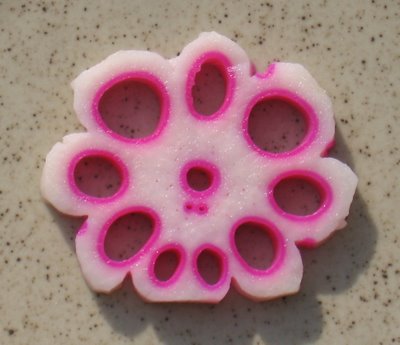
red and white auspicious renkon dish
renkon 蓮根 レンコン lotus roots
. . . CLICK here for Photos !
Lotoswurzeln
It is an auspicious food,since you can see through the holes of the root "into the future", saki ga mitooseru 先が見通せる, mitooshi ga kiku 見通しがきく, which is lucky. Therefore lotus dishes are always prepared for auspicious situations, festivals and the New Year food.
Lotus roots as food
.................................................................................
tazukuri たずくり young dried sardines (gomame) with seasoning
Wish for a good harvest.
Seasoned with sake, mirin and white sesame seeds.
uchiawabi, uchi awabi 打ち鮑 flattened abalone
auspicious pun about striking an enemy down (utsu 打つ).
These dishes were also served when a samurai returned home victoriously.
.................................................................................
yanagibashi やなぎばし chopsticks made from willowtree wood
The middle part is thickest. To use them for eating brings good fortune to the kids and grandkids and more descendants.
. Chopsticks as KIGO for the New Year
yatsugashira ヤツガシラ / 八つ頭 "eight eight heads"
satoimo サトイ モ Taro as kigo
Just as this parent potato has many child potatoes (sprouts), we eat it with the wish for many children and further generations.
. . . CLICK here for Photos !
*****************************
Worldwide use
China
Chinese New Year's rice cake (Chinese: Nian gao 年糕)
is a special kind of cake made of stick rice. Eating nian gao symbolizes elevating oneself higher in each coming year.
. . . CLICK here for Photos !
passing Chinatown...
the scent of nian gao wafts
my way home
Chen-ou Liu, Canada
*****************************
Things found on the way
*****************************
HAIKU
皺面にとそぬり付るわらひ哉
shiwazura ni toso nuritsukeru warai kana
he smears New Year's sake
all over his wrinkled face ...
what a laugh
Kobayashi Issa, 1821
*****************************
Related words
***** Pounding Rice (mochi tsuki) for the New Year Mochi
***** The New Year and its Kigo (shin nen)
essen zum Neuen Jahr
SAIJIKI of Buddhist, Shinto and other Ceremonies and Events of Japan
BACK TO
*********** SPRING FOOD
BACK TO
*********** WINTER FOOD
. WASHOKU
New Year Food and Decorations
MORE DISHES
WASHOKU :
YASAI . Vegetable SAIJIKI
WASHOKU :
FISH and SEAFOOD SAIJIKI
WKD : SAIJIKI New Year
:::::::::::::::::::::::::::::::::::::::::::::::::::::::::::::::::::::::::::::::::::::::::::::::::::


